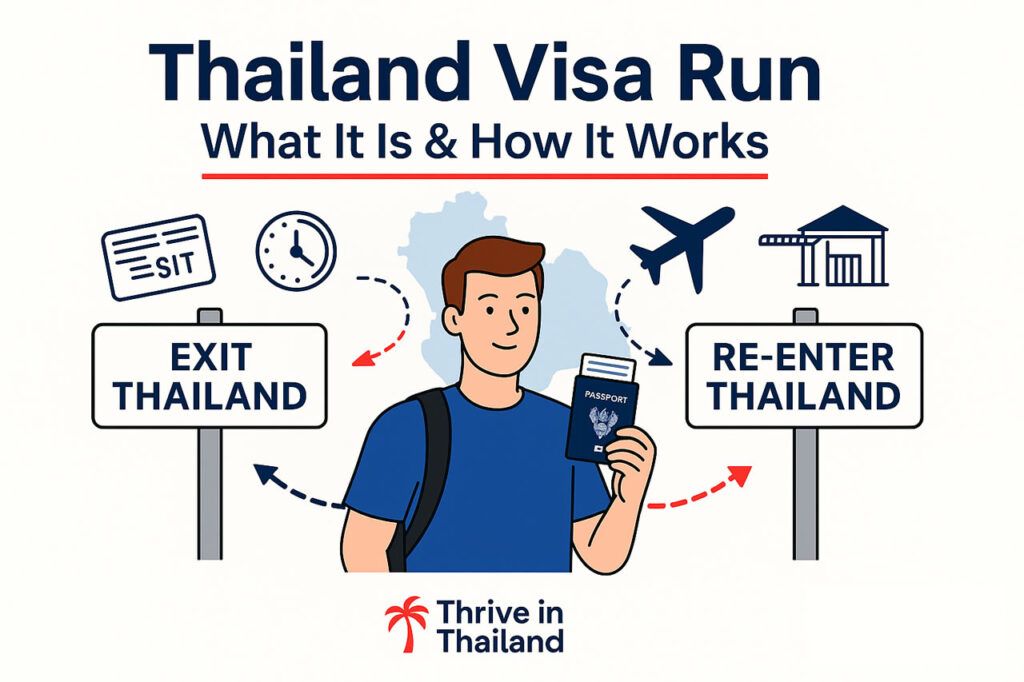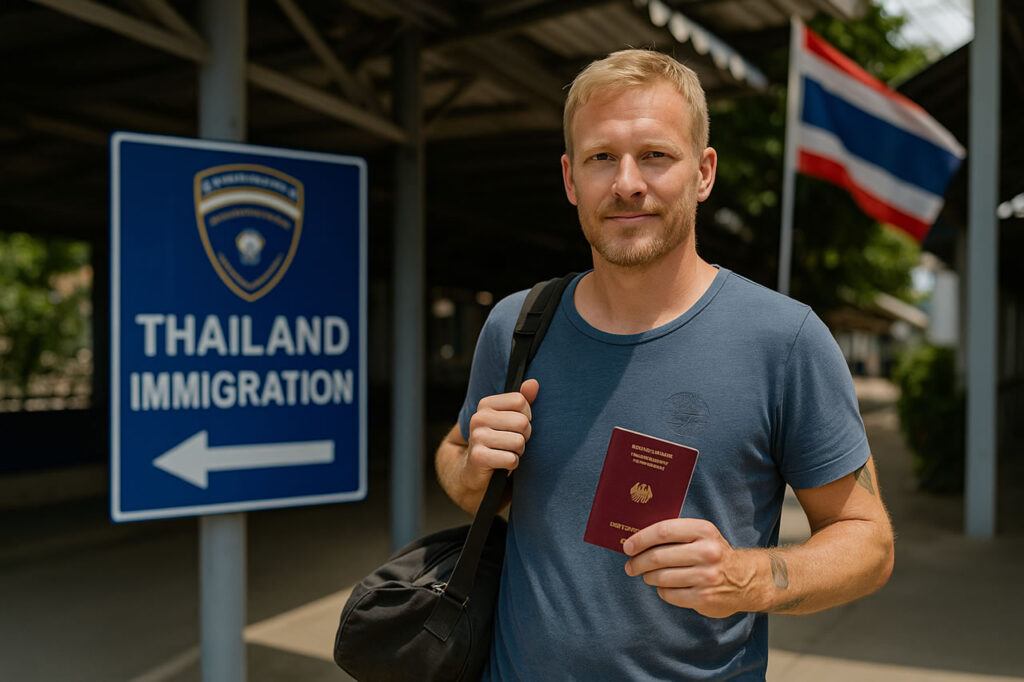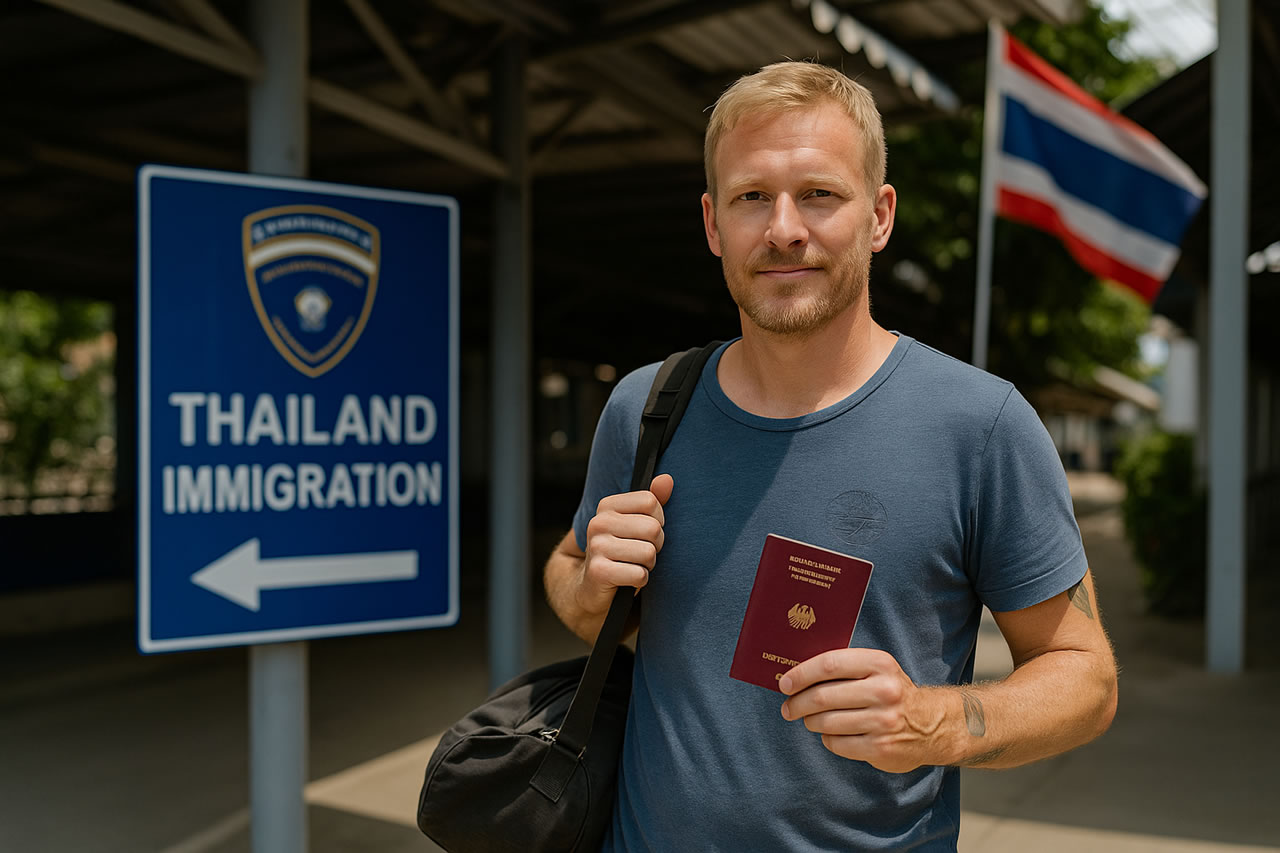
What Is a Visa Run?
A visa run is when you leave Thailand temporarily—usually by crossing a land border or taking a short flight—to “reset” your stay or apply for a new visa. Once you exit and re-enter the country, immigration grants you a fresh stamp based on your visa or exemption status.
This workaround is especially common among:
- Tourists on a 30- or 60-day entry who want to stay longer without applying for a new visa inside Thailand.
- Digital nomads and freelancers who don’t (yet) qualify for long-term visas.
- Expats in visa-limbo waiting for a proper visa to be processed or approved.
In most cases, the traveler leaves Thailand for just a day or two and returns with either:
- A new visa obtained at a Thai embassy or consulate abroad, or
- A fresh entry stamp under the visa exemption rule or an existing multiple-entry visa.
📌 But be warned—visa runs are not a long-term solution. Immigration officers are trained to spot frequent “border hoppers,” and re-entry is never guaranteed.
Is It Legal?
Yes—visa runs are technically legal, as long as you comply with Thai immigration laws. There’s no rule that says you can’t leave the country and come back. In fact, many visas—especially tourist visas and visa exemptions—allow multiple entries or re-entry under specific conditions.
📌 But here’s the catch: Thai immigration doesn’t just look at your passport stamps—they look at your pattern of behavior.
If you’ve been entering and exiting Thailand repeatedly, especially using back-to-back tourist visa exemptions or single-entry tourist visas, immigration officers may flag you for abusing the system. This is especially common at land borders, where officers are known to deny entry if they suspect you’re “living in Thailand on tourist visas.”
Thailand wants long-stayers to use the appropriate visa channels (like retirement, marriage, education, or business visas). The government has gradually tightened rules to discourage serial visa runners from treating tourist entries like a permanent solution.
In short:
- One or two visa runs? Likely fine.
- Frequent back-to-back runs? Risky.
- No valid reason for extended stays? You could be denied entry.
It’s legal—but not foolproof. Use it wisely.
⚠️ November 2025 Immigration Enforcement Update
As of mid-November 2025, Thai Immigration has significantly tightened enforcement on frequent tourist entries and visa runs.
While no new law was passed, Immigration officers nationwide received updated internal directives instructing them to:
- Scrutinize travelers who appear to be living in Thailand on repeated tourist entries
- Limit second tourist-entry extensions to as little as 7 days in some cases
- Deny re-entry if a visitor has too many back-to-back land or air entries
- Request proof of funds, accommodation, and onward travel more frequently
- Flag “border-hop patterns” in the digital entry system
📌 This means visa runs still exist — but re-entry is now more uncertain than ever.
If you’ve been relying on tourist stamps for long-term living, expect more questions, delays, and a higher chance of being turned away at the border.
For anyone planning to stay long-term, this is a strong signal to switch to the proper visa category (retirement, marriage, ED, business, LTR, DTV, etc.) rather than relying on repeated runs.
Types of Visa Runs
Not all visa runs are the same—some are quick day trips, others are mini getaways, and some are full-on consulate missions. Here’s a breakdown of the most common types:
1. Border Bounce (Land Crossing, Same-Day or Overnight)
This is the classic budget-friendly visa run. You hop on a minivan or bus to a nearby border—like Poipet (Cambodia), Vientiane (Laos), or Padang Besar (Malaysia)—get stamped out of Thailand, enter the neighboring country, then return to Thailand the same day or after one night.
- Best for: Extending visa-exempt entries or reactivating a multiple-entry visa
- Risk: Higher immigration scrutiny at land borders
- Cost: Low, but often tiring and rushed
2. Short Trip Abroad (Air Visa Run)
Instead of bouncing across a land border, you fly to a nearby country for a couple of days—Kuala Lumpur, Ho Chi Minh City, or Singapore are popular choices. These runs are more comfortable, and immigration tends to be less strict.
- Best for: Getting a fresh 30-day stamp or applying for a new tourist visa at a consulate
- Risk: Lower scrutiny, but still not guaranteed
- Cost: Higher, especially with airfare and hotel
3. Consulate Visit (Visa Application Run)
This is more of a “purposeful visa run” than a reset. You leave Thailand specifically to apply for a new visa at a Thai consulate or embassy abroad—typically a Tourist Visa, ED Visa, Non-Immigrant B or O, or the DTV.
Popular locations for this include:
- Vientiane or Savannakhet, Laos
- Penang or Kuala Lumpur, Malaysia
- Ho Chi Minh City, Vietnam
Best for: Switching visa types or starting a new long-term stay
Risk: Low if paperwork is complete
Tip: Always check the Thai consulate’s rules—some now require online appointments and specific documents
📌 In practice, many travelers combine these types depending on their situation and budget. But whichever route you take, plan carefully and don’t rely on the visa run lifestyle forever—it’s getting riskier each year.
Thailand Visa Runs Compared: Land Crossings vs. Air Travel
Curious how land and air visa runs compare? Here’s a quick side-by-side to help you decide which suits your situation best:
| Feature | Land Visa Run | Air Visa Run |
|---|---|---|
| Common Destinations | Laos, Cambodia, Malaysia (by land) | Malaysia, Vietnam, Singapore (by air) |
| Transportation | Bus, minivan, taxi | Flights (low-cost airlines) |
| Cost | THB 1,500–3,500 | THB 3,000–10,000+ |
| Time Required | 1–2 days (some same-day possible) | 1–3+ days (including flights and layovers) |
| Purpose | Border bounce or nearby consulate visit | New visa application or 30-day exemption reset |
| Immigration Scrutiny | Higher scrutiny, especially for frequent runs | Generally less scrutiny |
| Visa Application Options | Possible at consulates (e.g., Vientiane) | Easier access to well-staffed Thai embassies |
| Comfort & Convenience | Basic transport, long waits at border | More comfortable, but planning required |
| Risk of Entry Denial | Higher (especially for repeat runners) | Lower but still possible if abuse suspected |
| Best For | Budget-conscious travelers needing quick reset | Those applying for new visas or avoiding land borders |
✅ Now that you know the difference, let’s look at the most popular visa run destinations in more detail.
Popular Visa Run Destinations
If you’re planning a visa run, where you go matters. Some borders are fast and convenient, others offer better Thai consulates for visa applications. Here are the most common destinations for both land and air visa runs:
1. Vientiane, Laos
Best for: Tourist Visas, ED Visas, smooth consulate process
Thailand’s favorite visa run city. The Thai consulate in Vientiane is efficient and well-used to handling tourist, education, and non-immigrant visa applications.
- Bonus: Affordable stays, easy border crossing at Nong Khai
- Tip: Make an appointment online before visiting the consulate
2. Savannakhet, Laos
Best for: Tourist Visas, less crowded alternative to Vientiane
Quieter than Vientiane, this city near the Mukdahan border offers another Thai consulate with solid processing times.
- Bonus: Shorter queues, laid-back vibe
- Downside: Less infrastructure, more basic transport
3. Kuala Lumpur, Malaysia
Best for: Air visa runs, new visa applications
The Thai embassy in KL is well-organized and used to visa requests. KL is a modern city with great food, cheap flights, and efficient public transport.
- Bonus: Great infrastructure and quick turnarounds
- Watch out for: Strict document checks at the embassy—double-check the requirements
4. Ho Chi Minh City, Vietnam
Best for: Air runs and longer visa resets
Thailand’s consulate here is another option for new visas, and the city is well-connected with direct flights from Bangkok.
- Bonus: Vietnamese culture and great food make it a fun break
- Tip: Processing can vary—give yourself 2–3 business days
5. Poipet, Cambodia
Best for: Quick border bounces
The fastest and cheapest land run from Bangkok, but not the most pleasant experience. Expect crowds, touts, and long queues.
- Bonus: Cheap and same-day turnaround
- Warning: Immigration here is very strict with repeat runners
6. Padang Besar, Malaysia
Best for: Southern Thailand visa runs
A land border crossing between Songkhla Province and Malaysia. Calm, relatively straightforward, and good for those in the South.
- Bonus: Can combine with a train journey
- Tip: Check consulate hours in Penang if planning a visa application
📌 Each destination has its pros and cons, so choose based on your visa goals, budget, and where in Thailand you’re based. And always check Thai consulate websites for updated requirements and appointment systems before you go.
How Often Can You Do It?
There’s no official rule that says how many visa runs you can do—but immigration officers absolutely pay attention to patterns.
If you’re coming in and out of Thailand every few weeks, always using tourist visas or visa-exempt entries, it’s a red flag. Officers may start to suspect you’re using short-term entries to live in Thailand long-term without the proper visa.
Here’s what to keep in mind:
Immigration Has Discretion
Even if you’re legally eligible for another entry, Thai immigration can deny re-entry if they feel you’re abusing the system. This is especially common at land borders, where officers are stricter with frequent runners.
What They Might Look At
- Number of visa runs in your passport
- Frequency of entries within a short time span
- Type of visa (tourist vs. long-stay)
- Proof of outbound flights or onward travel
- Supporting documents (like funds, accommodation, or reason for return)
Real Talk from the Border
Travelers report being grilled with questions like:
- “Why are you coming back to Thailand again?”
- “How do you support yourself?”
- “Are you working here?”
📌 If you can’t answer confidently—or if you’ve done one too many runs—you could be denied entry, even if you’ve done nothing technically illegal.
Rule of Thumb
- A few visa runs a year? Generally okay, especially if spaced out and with valid reasons.
- A visa run every month or two? Risky.
- Living in Thailand on tourist stamps for 6+ months? Very risky—and likely to get flagged.
📌 To play it safe, use visa runs sparingly, and start planning for a proper long-term visa if you want to stay in Thailand without the stress.
Risks and Immigration Scrutiny
Visa runs might seem like a clever workaround, but Thai immigration has seen it all—and they’ve been tightening the screws in recent years. If you’re relying too heavily on tourist entries or frequent re-entries, you’re on thin ice. Here’s what you need to know:
Re-Entry Is Not Guaranteed
Even if you’re technically allowed to enter (e.g., under visa exemption or with a valid visa), immigration officers can deny you at the border if they suspect you’re misusing the system.
You might hear:
“You’ve been in Thailand too often. You need to apply for the proper visa.”
📌 They don’t have to let you in—and there’s no appeal process at the checkpoint.
Warning Signs That May Trigger Scrutiny
- Multiple back-to-back tourist entries in a short time
- Lack of a clear purpose for your stay
- No proof of funds or onward travel
- Vague answers to immigration questions
- Entry via land borders (which are more heavily monitored)
Common Consequences
- Verbal warning or note in the system
- Denied entry and forced return on the next bus or flight
- Blacklisting in extreme cases (rare, but it happens)
- Requirement to show documentation (onward ticket, bank balance, accommodation)
Real-World Example
A traveler using visa exemptions and back-to-back tourist visas for over a year was denied re-entry at the Cambodian border—even though he had never overstayed. He was told, “You’ve stayed in Thailand too much. Come back with a visa.”
Moral of the story: Immigration is looking at the intent, not just the paperwork.
📌 If you’re serious about staying in Thailand long-term, visa runs should be your temporary Plan B—not your lifestyle.

Tips for a Smooth Visa Run
A successful visa run isn’t just about hopping the border—it’s about showing immigration that your travel is legitimate and well-prepared. Here’s how to improve your chances of getting back into Thailand without hassle:
1. Dress Neatly & Be Polite
Immigration officers do judge a book by its cover. Avoid looking like a backpacker who’s been “living off the grid.”
📌 Casual is fine—just keep it clean, respectful, and presentable.
2. Bring Supporting Documents
Always carry:
- A return/onward flight ticket
- Proof of accommodation (hotel or rental booking)
- Bank statements or cash to show financial means
- A printed copy of your visa (if applicable)
📌 Even if they don’t ask, it shows you’re prepared—and serious.
3. Be Ready to Answer Questions
Immigration may ask:
- “Why are you coming back to Thailand?”
- “How long do you plan to stay?”
- “What do you do for work?”
📌 Have clear, honest answers. Rambling or getting flustered can raise suspicions.
4. Prefer Air Over Land (When Possible)
Land borders are cheap—but also stricter. Air entries tend to face less scrutiny, especially if you haven’t done many recent runs.
5. Space Out Your Visa Runs
Don’t re-enter Thailand too soon after your last exit. Give it a few weeks or more between runs. Frequent back-to-back entries are the biggest red flag.
6. Know When to Switch Strategies
If you’ve done multiple visa runs, it’s time to start planning for a long-term visa. Whether it’s retirement, education, business, or the new DTV—Thailand has better options than risking a denial at the border.
📌 Visa runs can still work if done occasionally and responsibly. Think of them as a temporary fix—not a way of life.
Alternatives to Visa Runs
Visa runs might buy you time, but they’re not a stable solution—and Thai immigration knows it. If you’re serious about living in Thailand, it’s worth exploring legit long-term visa options that offer peace of mind (and fewer border trips).
Here are the most reliable alternatives:
1. Retirement Visa (O-A or O-X)
Perfect for those aged 50+. Offers annual or 5–10 year stays, depending on the type.
- Requires: Proof of funds, health insurance, police check (O-A/X)
- Ideal for: Retirees who want to settle down without hassle
➤ Full Guide to the O-A Retirement Visa
2. Marriage Visa (Non-O)
If you’re legally married to a Thai national, this visa allows year-to-year extensions.
- Requires: Proof of marriage and financial support (bank balance or income)
- Good for: Expats in long-term relationships living in Thailand
3. Business Visa + Work Permit (Non-B)
For those employed or running a registered Thai company. Comes with a work permit and legal status.
- Requires: Thai employer or your own company, proper salary, taxes, etc.
- Serious commitment, but offers long-term stability
➤ Thailand Business Visa (Non-Immigrant B Visa)
4. SMART Visa or LTR Visa
Modern long-term visas aimed at professionals, investors, and digital-savvy expats.
- SMART Visa: For tech, startups, and skilled experts
- LTR Visa: For wealthy retirees, digital nomads, and professionals
- Bonus: No 90-day reporting (for some categories)
➤ SMART Visa Guide | LTR Visa Guide
5. Education Visa (ED Visa)
Want to learn Thai or study in Thailand? The ED visa allows longer stays tied to an approved institution.
- Requires: Enrollment in a licensed school and regular attendance
- Note: Heavily monitored due to past abuse
6. Destination Thailand Visa (DTV)
A newer option for digital nomads, freelancers, and cultural participants.
- 5-year multiple entry, 180-day stays per entry
- Must work for foreign clients/employers only
📌 These visas aren’t just safer—they’re often more cost-effective in the long run. They help you avoid visa stress, border trips, and the risk of being turned away.
Recent Trends & Immigration Changes (2024–2025)
Thai immigration policy is always evolving—and in recent years, the trend has been clear: fewer loopholes, more long-term solutions.
If you’re thinking about relying on visa runs, here’s what’s changed lately and why it matters:
1. Crackdown on Frequent Visa Runners
Thai immigration now uses digital entry records to flag repeat entries. You might be asked:
- Why are you coming back again so soon?
- What do you do for income?
- Are you working illegally?
📌 Especially at land borders, officers are turning away travelers they believe are staying long-term on short-term entries.
2. Stricter Land Border Crossings
Land borders used to be the go-to for quick, cheap visa runs—but they’re now the most heavily monitored. Many expats report that multiple land entries in a year trigger questions or outright denial.
Tip: Limit land border runs if possible—airports are generally more lenient (but still not immune).
3. More Consulates Requiring Online Appointments
Many Thai embassies and consulates abroad now require:
- Online appointments
- Proof of accommodation and income
- Outbound travel confirmation
- Printed, complete documentation
📌 Always double-check the local consulate’s website before your trip—walk-ins are no longer a guarantee.
4. Focus on Long-Term Visa Options
Thailand’s immigration strategy is shifting from tolerance of “visa tourism” to encouraging:
- Digital nomads (via the DTV Visa)
- High earners, retirees, and professionals (via LTR and SMART Visas)
- Legitimate residents with family or study connections
📌 In short: the government is rewarding those who play by the rules—and tightening up on those who don’t.
Bottom Line
If you plan to stay in Thailand long-term, it’s time to think beyond visa runs. Immigration policy is moving toward transparency, accountability, and data tracking—and the old tricks won’t last forever.
Visa runs used to be the expat’s secret weapon—a quick dash to the border, a fresh stamp, and back to the good life. But times have changed. Immigration is smarter, the systems are stricter, and the message is clear: visa runs are a temporary patch, not a long-term plan.
If you’re just visiting Thailand or bridging the gap while waiting for a proper visa, a well-timed visa run can still work. But if you’re building a life here, it’s time to invest in a more stable solution.
✅ Explore the right visa for your lifestyle—retirement, marriage, business, or one of Thailand’s newer long-stay options. They’ll save you stress, money, and the awkward stares at the border.
And remember: The goal isn’t just to stay in Thailand—it’s to thrive here.
| 📌 Looking for more visa help? |
|---|
| ✅ Thailand Visa Hub – Your central guide to all visa types, rules, and long-term options. |
| ✅ Visa Finder Tool – Answer a few quick questions and see which visa best fits your situation. |
| ✅ Visa Stay Calculator – Check expiry dates, 90-day reports, and plan visa runs with ease. |
💬 Have a favorite route or a visa run gone wrong? Share your tips and tales in the comments!

